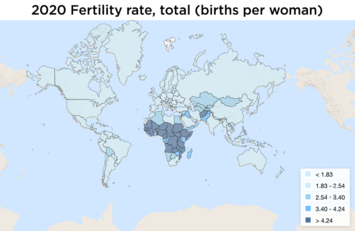
Yesterday, Tyler Cowan mentioned in the Marginal Revolution blog that he wished books on urban areas “would spend more time discussing whether dense urban areas are simply a fertility trap.” I’m not going to write a book about it, but it may be one more reason why planners’ mania for density is a bad idea.
There appears to be a correlation between state fertility rates and land-use regulation aimed at increasing urban densities. Click image to go to a Wikipedia article on fertility rates by state.
A fertility trap, sometimes called a low fertility trap, is a situation where a nation’s birth rate has declined below the replacement rate of 2.1 children per woman. Within a generation, this leads to a reduction in the number of young people working, which means — in a country that has a social security system, as most developed countries do — the number of older people that each young person must support increases.
This has become a serious demographic problem for nations around the world. As various lists of fertility rates reveal, the only nations producing more than replacement numbers tend to be poor, developing countries, while nations in Europe, North America, and many parts of Asia are well below replacement rates.
Lower birthrates are commonly ascribed to better educational systems for women. This puts them into the work force and reduces the number of years that they might be willing to bear and care for children. But this doesn’t necessarily reduce birthrates to 1.1, which is the rate found in Korea. France, Australia, Sweden, and the United States are all around 1.8, which is still below replacement but well above South Korea.
China, of course, long had a one-child-per-family policy, at least in urban areas, yet it has an overall birthrate of 1.7, which is nearly as high as in the U.S. and well above Singapore, South Korea, and other countries that haven’t overtly tried to discourage child bearing.
The first time I heard low birth rates associated with density was a video about Russian demographics by Peter Zeihan. “Krushchev forced everybody into condos which reduced the birth rate,” he observed.
In 1965, Russian urban planners published a book titled The Ideal Communist City that argued that everyone should live in tiny apartments in mid-rise or high-rises. This would allow everyone to travel by mass transit and avoid the need for automobiles, traffic congestion, and urban sprawl. (The book is downloadable and my review of it and its relationship to American urban planning is here.)
Read the rest of this piece at The Antiplanner.
Randal O'Toole, the Antiplanner, is a policy analyst with nearly 50 years of experience reviewing transportation and land-use plans and the author of The Best-Laid Plans: How Government Planning Harms Your Quality of Life, Your Pocketbook, and Your Future.
Lead graph: The World Bank, under CC 4.0 License. US fertility rate graph, courtesy The Antiplanner.














Quick look at the map
Suggests fertility has more to do with the cultures within each state than it does to wide-open spaces.